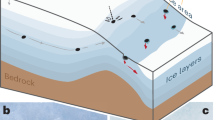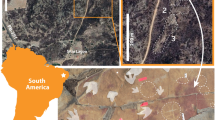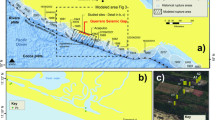Abstract
The historical credibility of texts from the Bible is often debated when compared with Iron Age archaeological finds (refs . 1, 2 and references therein). Modern scientific methods may, in principle, be used to independently date structures that seem to be mentioned in the biblical text, to evaluate its historical authenticity. In reality, however, this approach is extremely difficult because of poor archaeological preservation, uncertainty in identification, scarcity of datable materials, and restricted scientific access into well-identified worship sites. Because of these problems, no well-identified Biblical structure has been radiometrically dated until now. Here we report radiocarbon and U–Th dating of the Siloam Tunnel3,4,5,6,7,8,9,10, proving its Iron Age II date; we conclude that the Biblical text presents an accurate historic record of the Siloam Tunnel's construction. Being one of the longest ancient water tunnels lacking intermediate shafts11,12, dating the Siloam Tunnel is a key to determining where and when this technological breakthrough took place. Siloam Tunnel dating also refutes a claim13 that the tunnel was constructed in the second century bc.
This is a preview of subscription content, access via your institution
Access options
Subscribe to this journal
Receive 51 print issues and online access
$199.00 per year
only $3.90 per issue
Buy this article
- Purchase on Springer Link
- Instant access to full article PDF
Prices may be subject to local taxes which are calculated during checkout


Similar content being viewed by others
References
Finkelstein, I. & Silberman, N. The Bible Unearthed: Archaeology's New Vision of Ancient Israel and the Origin of Sacred Texts (Simon & Schuster, New York, 2001)
Montgomery, J. A. A Critical and Exegetical Commentary on The Book of Kings (Scribner, New York, 1951)
Vincent, L. H. Underground Jerusalem: Discoveries on the Hill of Ophel (1909–11) (Horace Cox, London, 1911)
Amiran, R. in Jerusalem Revealed (ed. Yadin, Y.) 75–78 (Israel Exploration Society, Jerusalem, 1976)
Ussishkin, D. The original length of the Siloam Tunnel in Jerusalem. Levant 8, 82–95 (1976)
Shaheen, N. The sinous shape of Hezekiah's Tunnel. Palestine Exploration Fund Quarterly Statement, January–June, 103–108 (1979)
Gill, D. Subterranean waterworks of Biblical Jerusalem: Adaptation of a karst system. Science 254, 1467–1471 (1991)
Abells, Z. & Arbit, A. The City of David Water Systems (Hadassah College, Jerusalem, 1995)
Mazar, A. Jerusalem's water supply in the First Temple Period. in The history of Jerusalem (eds Ahituv, S. & Mazar, A.) 195–232 (Yad Izhak Ben-Zvi, Jerusalem, 2000)
Reich, R. & Shukron, E. Reconsidering the karstic theory as an explanation to the cutting of Hezekiah's Tunnel in Jerusalem. Bull. Am. Sch. Orient. Res. 325, 75–80 (2002)
Issar, A. S. The evolution of the ancient water supply system in the region of Jerusalem. Israel Explor. J. 26, 130–136 (1976)
Tsuk, T. Ancient Water Systems in Settlements in Eretz-Israel (Tel Aviv Univ., 2000)
Rogerson, J. & Davies, P. R. Was the Siloam Tunnel built by Hezekiah? Bibl. Archaeologist 59, 138–149 (1996)
Sasson, V. The Siloam Tunnel inscription. Palestine Exploration Fund Quarterly Statement 114, 111–117 (1982)
Della-Vida, G. L. in In Memoriam Paul Kahle (BZAW103) (eds Black, M. & Fohrer, G.) 162–166 (Topelmann, Berlin, 1968)
Hackett, J. A. et al. Defusing pseudo-scholarship: The Siloam inscription ain't Hasmonean. Bibl. Archaeol. Rev., March–April, 41–50 (1997)
Shimron, A., Frumkin, A., Rosenbaum, J., Deutch, Y. & Dvoracek, M. The significance of geological structures, cave sediments and hydraulic lime in the interpretation of the subterranean waterworks beneath ancient Jerusalem. Geol. Surv. Israel Curr. Res. 12, 247–256 (2000)
Amit, D., Patrich, J. & Hirschfeld, Y. The aqueducts of Israel. J. Roman Archaeol. Suppl. Ser. no. 46, (Journal of Roman Archaeology, Portsmouth, Rhode Island, 2002).
Hedges, R. E. M., Law, I. A., Bronk Ramsey, C. & Housley, R. A. The Oxford accelerator mass spectrometry facility: Technical developments in routine dating. Radiocarbon 31, 99–113 (1989)
Bronk Ramsey, C. Radiocarbon calibration and analysis of stratigraphy: The OxCal program. Radiocarbon 37, 425–430 (1995)
Stuiver, M. et al. INTCAL98 radiocarbon age calibration, 24,000–0 cal BP. Radiocarbon 40, 1041–1083 (1998)
Kaufman, A. et al. U–Th isotope systematics from the Soreq Cave, Israel and climatic correlations. Earth Planet. Sci. Lett. 156, 141–155 (1998)
Frumkin, A., Ford, D. C. & Schwarcz, H. P. Continental oxygen isotopic record of the last 170,000 years in Jerusalem. Quat. Res. 51, 317–327 (1999)
Frumkin, A. & Shimron, A. in 11th International Conference on Water in Antiquity (eds Fahlbusch, H., Meshel, Z., Peleg, Y., Porath, Y. & Tsuk, T.) 4, (Tel Aviv University, 2001)
Frumkin, A. 9th Congreso International de Espeleologia 264–267 (Union Internacional de Espeliogia, Barcelona, 1986)
Gill, D. in Excavations at the city of David 1978–1985 (Qedem 35) (eds Ariel, D. T. & de Groot, A.) 1–28 (Institute of Archaeology, Hebrew University, Jerusalem, 1996)
Acknowledgements
We thank U. Piner (Israel Cave Research Center) for assistance during the initial survey; S. Ashkenazi and Y. Peled (Geological Survey of Israel) for performing the drilling programme; the Research Laboratory for Archaeology and History of Art, Oxford University, for radiocarbon dating; the Open University, Milton Keynes, for 230Th/234U dating; C. Doherty (plaster and mortar) and P. Pettitt (radiocarbon) and Y. Elitzur for discussions, and K. Allred for surveying a new map of the Siloam Tunnel. The National Center for Cooperation Between Science and Archaeology provided financial assistance. Israel Antiquities Authority and Nature and Parks Authority permitted the study.
Author information
Authors and Affiliations
Corresponding author
Ethics declarations
Competing interests
The authors declare that they have no competing financial interests.
Rights and permissions
About this article
Cite this article
Frumkin, A., Shimron, A. & Rosenbaum, J. Radiometric dating of the Siloam Tunnel, Jerusalem. Nature 425, 169–171 (2003). https://doi.org/10.1038/nature01875
Received:
Accepted:
Issue Date:
DOI: https://doi.org/10.1038/nature01875
This article is cited by
Comments
By submitting a comment you agree to abide by our Terms and Community Guidelines. If you find something abusive or that does not comply with our terms or guidelines please flag it as inappropriate.



